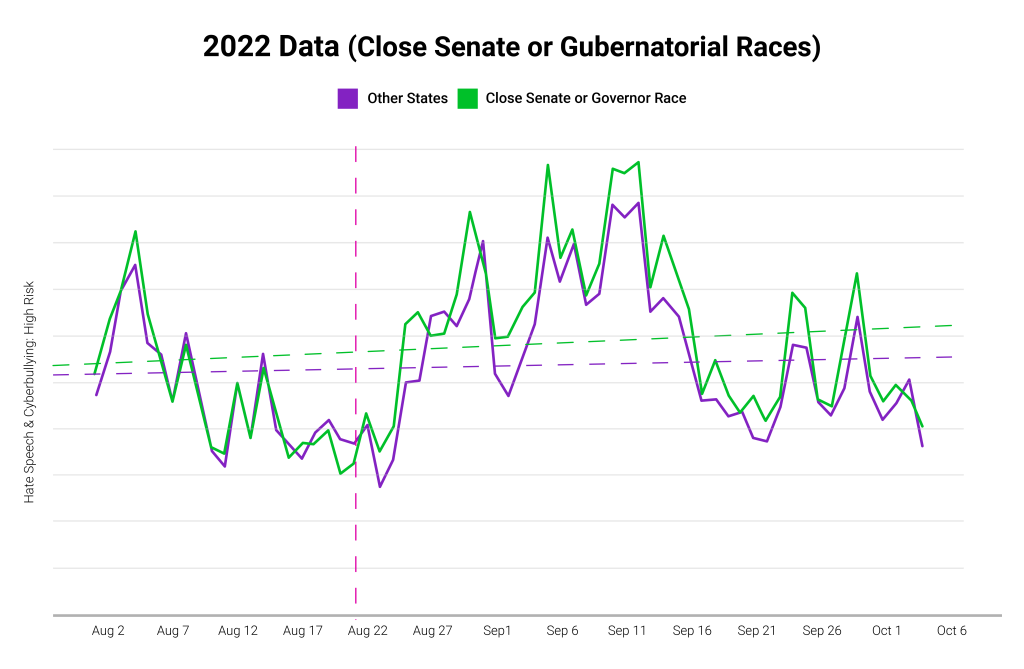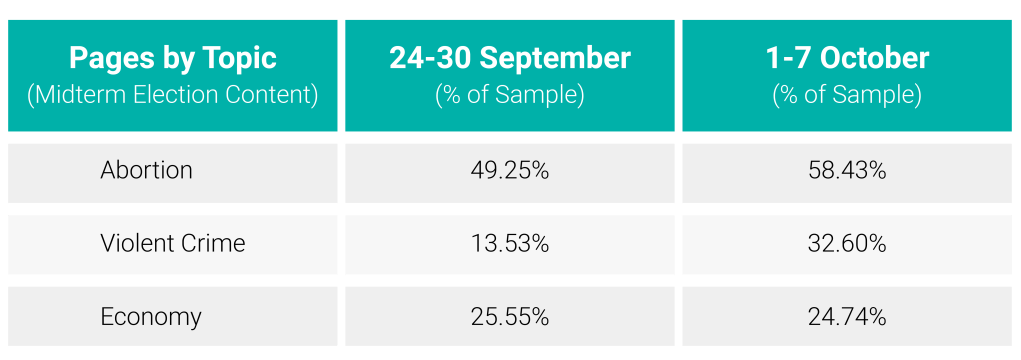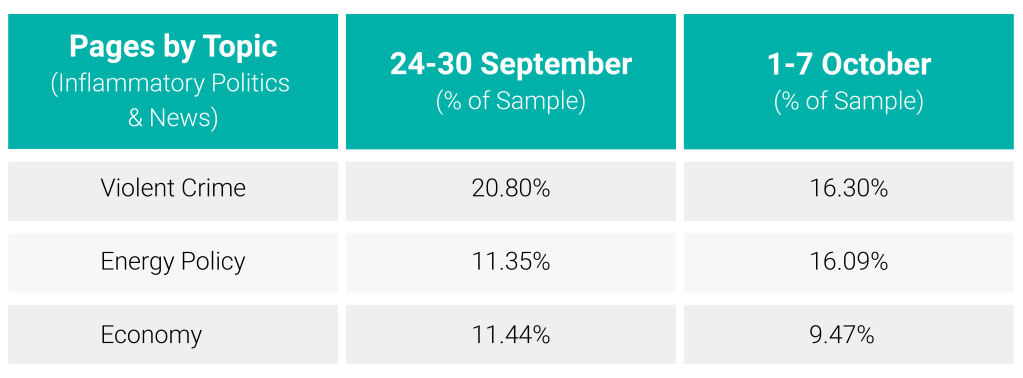Election news cycles can be among the most challenging for advertisers to navigate, as DV discovered in a 2020 special report that explored the correlation between fast-paced news cycles and incendiary content. To help advertisers navigate the media landscape ahead of the 2022 U.S. midterm elections and 2024 U.S. general elections, DV formed the DV Election Task Force. This multidisciplinary group brings together a team of brand safety, suitability and content moderation specialists, as well as fraud experts from DV’s industry-leading Fraud Lab.
Weekly News Cycle Insights
Each day, DoubleVerify analyzes billions of impressions on the open web – spanning websites, mobile apps, message boards and blogs – to help keep brands safe from appearing alongside unsafe and unsuitable content. Publishers promoting specious or racially biased/motivated claims are classified into DV’s Inflammatory Politics and News and Hate Speech categories, respectively (see full definition of these categories in the following section).
These category classifications allow advertisers to protect their brand reputation and ensure their ad dollars do not inadvertently fund harmful content. DV is able to track the scale of these categories via our monitored category traffic, which, given its large volume, serves as a relative proxy for traffic trends.
With this data, the DV Election Task Force is now providing weekly analysis to highlight ongoing trends ahead of and during the election news cycles. This inaugural blog will cover the months leading up to the election from August 1 – October 7. Next week, we will review findings from the rest of October before beginning a weekly analysis.
Read on to discover content trends for the months leading up to the election.
Incendiary Content Analysis: August, September and Early October
The analysis below focuses on insights from DV’s Hate Speech and Inflammatory Politics and News Categories.
DV’s technology classifies hate speech as content that is related to biased, derogatory or offensive actions directed toward any individuals or groups (race, ethnicity, gender, sexual orientation, religion, ability, etc.), including any content that may incite violence against individuals or groups within a protected class.
Inflammatory Politics and News covers news or political content associated with or exhibiting inflammatory points of view; potentially fake, unreliable or unsubstantiated information; significant political intolerance, hateful or threatening rhetoric; or other significantly controversial elements.
Hate Speech Surges as Elections Near
DV’s ongoing analysis of category traffic rates associated with High-Risk Hate Speech began on August 1 and compares states with close senate and gubernatorial races to those without close races. The list of close races is composed of “battleground” races identified by the nonprofit and nonpartisan online political encyclopedia Ballotpedia.

Between August 1 and August 21st, the average rate of High Risk Hate Speech, which is how DV classifies the most derogatory and potentially dangerous hate speech, remained close for both subsets of states. As September approached, however, and the midterm election cycle went into full swing, DV observed that the average rate of High Risk Hate Speech increased markedly.
Key Takeaways
Average rates of hate speech have increased by nearly one-quarter (+23%) across all states in the weeks leading up to the November midterms (compared with the early weeks of August)). And for states with close senate or governor races, the increase in the average rate was even greater (+31%) – notably surpassing the increase seen in states without close elections (+19%).
In addition, in geographically ranking hate speech by rate during the weeks of August 1 – October 4, DV found that the top-five states for hate speech were:
- Kansas
- Arizona
- Mississippi
- Vermont
- Louisiana
Top Content Themes Emerge Across Election Coverage and Inflammatory Politics and News
Beginning in mid-September, the DV ontology team, who use machine learning to analyze web page content and identify topics, began tracking the percentage of pages where the top 10 midterm voting issues appear. These issues are defined by Pew Research and include, in alphabetical order:
- Abortion
- Economy
- Education
- Energy Policy
- Gun Policy
- Health Care
- Immigration
- Supreme Court Appointments
- Violent Crime
- Voting Policy
This capability allows DV’s task force to track the frequency and prevalence of specific topics being mentioned over time. In addition to analyzing a sampling of pages based on mentions of the midterm elections, the DV Election Task Force also began analyzing the percentages of these pages that were classified as Inflammatory Politics and News.
Key Takeaways
Although media commentators and pollsters have been split when it comes to the importance of abortion as a key midterm voting issue, relative to other topics like the economy and crime, DV findings show that its prevalence increased over time. And it ultimately became the most prevalent issue by mid-September (across DV-tracked content related to the midterms).

But when it came to Inflammatory Politics and News, specifically, abortion was only the fourth most prevelant topic in DV’s sampling of pages (which began the week of September 24). Violent crime, the economy and energy policy each accounted for more pages classified as Inflammatory Politics and News.

The DV Election Task Force Long-Term Initiative
During an election, it is often difficult to predict potentially controversial topics and how they’ll evolve from one hour to the next. The DV Election Task Force will continue monitoring election and political content globally, and in real time, to help ensure advertisers keep pace with new issues as they arise.
If you have questions about brand safety and suitability as it pertains to the election news cycle, please reach out to Sales@DoubleVerify.com.

